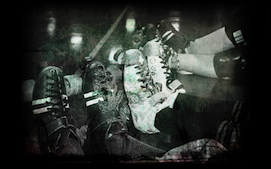Shopping For Skate Boots
November 19, 2009
Many things need to be considered when purchasing a pair of roller derby skate boots.
Fit
A properly fitted skate boot is snug when new, but not so tight it is uncomfortable. Your toes should be about a quarter inch from the end while standing in the boot. The skate boot should not be too loose or too long, and your heel should not slip when the boot is fully laced. When you start skating, long or loose skates will get even looser. If your feet are sliding around in a too-big boot, you will get painful blisters and calluses, even with thick socks on. Too-small boots can also cause blisters, calluses, foot pain, and numbness.
If you have unusually narrow feet, small heels, flat arches, or very wide feet, consider spending a little extra money (usually about an additional $60 for certain standard customizations) to have skates custom made to fit your feet. Another option is to try skates that allow you to custom-mold the foot bed of the skate.
 It probably goes without saying, but you need to try on skates before you purchase. Make sure that you try them on with the type of socks you will wear to practice and games. If you wear insoles, bring a new pair with you. Feet swell during the day, and most of us play at night, so do your skate shopping in the evening when your feet are at their largest. If you can’t try on skates before you buy, check the store’s return policy before you purchase. If you can’t return them you should not buy them.
It probably goes without saying, but you need to try on skates before you purchase. Make sure that you try them on with the type of socks you will wear to practice and games. If you wear insoles, bring a new pair with you. Feet swell during the day, and most of us play at night, so do your skate shopping in the evening when your feet are at their largest. If you can’t try on skates before you buy, check the store’s return policy before you purchase. If you can’t return them you should not buy them.
Boot Type
Most roller derby skaters choose track, speed, or jam skating boots. Track boots are modeled after speed boots, but with additional features designed specifically for derby. Track and speed boots have more internal support, known as a “counter,” for going fast and turning left. Jam skating boots tend to have less counter-support to allow for ease in making more dramatic lateral moves, and have a lower profile at the ankle. Jam skating boots are not recommended for skaters with weak ankles. Another option, popular with former-hockey players, are roller hockey boots. Roller hockey boots are usually made of a mix of leather and synthetic materials and have more padding than a traditional skate boot. They generally have a slightly higher, softer collar than track, speed, or jam boots.
Boot Materials and Quality
Most roller skate boots are made with leather or vinyl, and/or other synthetic materials.
Vinyl
Vinyl is most commonly found in low-end, recreational skate models. They tend to be good boots for beginners because vinyl does not need to be broken in, has a forgiving fit, and costs substantially less than quality leather. However, vinyl does not stand up well to serious skating, nor does it “breathe.” Vinyl boots can be good for newer skaters, but they will rarely last longer than a season. For serious athletes with ethical issues regarding leather products, vinyl skates can be a good compromise when outfitted with better quality plates and accessories.
Leather
Low-end recreational leather skates are rarely better than vinyl. The pressed leather is usually coated with “stiffeners” that make it more difficult to get a proper fit, which can lead to uncomfortable blisters, calluses, and, in the worst case, issues with hairline fractures and permanent foot damage if the skates are too tight. Low-end recreational leather skates are not meant for serious skaters, as they often feature the same poor quality plates, hardware, and mounting commonly found on vinyl skates.
Quality leather boots of the right size will break in to fit the exact shape of the skater’s feet, and will not cause blisters, calluses, or discomfort when skating. Quality leather is also extremely durable and, when cared for properly, can last the duration of your derby career.
Real. Strong. Athletic. Revolutionary.